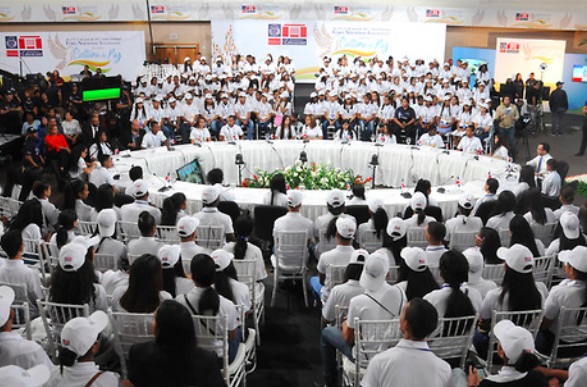… EDUCATION FOR PEACE …
An article from Acento (translation by CPNN)
For three days the Ministry of Education held the National Forum for a Culture of Peace. With the enthusiastic presence of Minister Andrés Navarro, some 360 students represented the 18 educational regions at the national level contributed proposals to address the increase in violence in Dominican schools.

We appreciate that Minister Andrés Navarro dedicates time and focus attention to this issue, and that the students of the country have been considered an essential part of the search for solutions in a subject that directly involves them.
Violence in schools is an old problem. The schools are located within communities that also have problems of violence: structural violence of society, family violence, gender violence, social violence. The violence that worries us today has always been in schools, but it is only now that we have instruments to recognize this violence, and show it outside the classroom, through social networks, and from there to more formal means of communication .
We never before had an education minister who discussed three days with students, listening to their concerns and suggestions on how to deal with violence. It’s a breakthrough. The Ministry of Education should make decisions about how to take on new technologies in schools, especially smartphones, which in some schools are forbidden while in others are allowed. They should not be instruments for distraction, but they can be instruments for information, for school work. New technologies should be incorporated as a support and not as an enemy.
(Article continued in right column)
What is the relation between peace and education?
Where is peace education taking place?
(continued from left column)
The other important issue is that students who go to school and are violent, or are victims of violence, or are spectators of acts of violence, come from homes with permanent or systematic violence, where there are aggressors and victims. These families can not be left out of the solutions. The school must find a way to incorporate the families of the students to solve the problem and to promote a culture of peace and respect.
The Ministry of Education will not be able to do anything with students who in the classrooms are instructed for a culture of peace if a culture of violence continues around them in the streets and in their homes.
There are working methods that the Ministry of Education could well assume in addition to this three-day meeting promoting a culture of peace. They should establish a dynamic that will involve teachers, school district coordinators, school directors and high schools.
The specialist Vanesa Espaillat, deputy director of the Lux Mundi School and professor at UNIBE University, has established that in any act of violence in the school context there are three actors: An aggressor, a victim and a public spectator. The public should be incorporated as part of the solution, and not left out as a simple observer.
No one who witnesses abuse or victimization in the school setting can remain indifferent. Teachers must be trained to deal with these events, and when they occur they should take advantage of them to nuance and emphasize the culture of peace, self-control, rejection of violence and taking responsibily.
The Ministry of Education needs to obtain an in-depth view to provide far-reaching solutions to this problem. It cannot solve it alone, because it does not depend only on the authorities, but it can help to find the door for its reduction.
We congratulate the Minister of Education, Andrés Navarro, for initiating the search for answers to an issue that worries the whole society. These initiatives can bring tranquility and serenity to the sector of education which so vital for families and for society.